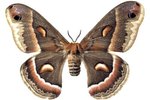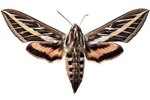
Caterpillars are the larvae of butterflies and moths. Belonging to the scientific order Lepidoptera, there are more than 500,000 species of caterpillars. Most are leaf eaters, consuming only one type or a family of plants. A few species are carnivorous. Caterpillars spend their entire larval stage eating in preparation for their pupal stage and metamorphosis to adulthood.
Physical Qualities of a Caterpillar
Caterpillars' bodies are soft and elongated. Segmented, they have three pairs of jointed front legs, and two to five pairs of thicker, unjointed abdominal legs. Caterpillars can be a 0.16 inch to 6 inches long, and are seen in a variety of colors and patterns, as distinctive as the butterflies and moths they will become. Some species sport horns, spines or hair, while others are smooth skinned. Caterpillars use their chewing mouthparts to defoliate their host plants.
Handling Plant Toxins
Some plants contain toxic chemicals to protect themselves from caterpillars and other plant eaters. Tomato hornworms consume the leaves of nightshade family plants, leaving the large veins intact to reduce the amount of toxins they consume. Some caterpillars, such as monarchs, absorb and retain toxins from their larval stage into adulthood, and use them for their own defense against predators. Vivid colors often serve as a warning of their toxicity.
Leaf-Eating Styles
Different herbivorous caterpillar species have different eating styles. Leaf miners eat only the top and bottom layers of the leaves, leaving brown spots, or transparent looking leaves. Free feeders consume almost the entire leaf, leaving behind only the thick main veins. Skeletonizers leave all of the leafs' veins intact, creating a lacy appearance. Leaf rollers wrap silk strands around the host plants' stems and leaves before eating them.
Predatory Carnivores
Only about 200 caterpillar species are carnivorous. While most predatory snails eat small, soft-bodied insects, the Hyposmocoma molluscivora of Maui eats only snails, and will starve himself if he's unable to find them. He's the only caterpillar discovered that eats shelled animals, wrapping the snail in silk to immobilize it before eating it alive. The Maculinea alcon butterfly's larva spends his first two weeks feeding on marsh gentian flowers before dropping to the earth coated with waxy hydrocarbons. The waxy camouflage smells like Myrmica ant larvae. Unwitting ants carry the caterpillar into their nest and feed him where the caterpillar then eats the ants.
References
Photo Credits
-
Hemera Technologies/Photos.com/Getty Images
Writer Bio
Karen Mihaylo has been a writer since 2009. She has been a professional dog groomer since 1982 and is certified in canine massage therapy. Mihaylo holds an associate degree in human services from Delaware Technical and Community College.




